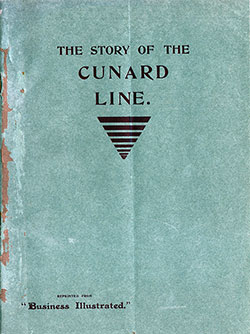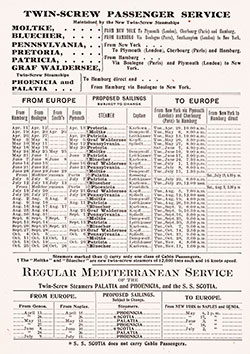RMS Scotia Archival Collection
Scotia (1862) Cunard Line
Built by Robert Napier & Sons, Glasgow, Scotland. Tonnage: 3,871. Dimensions: 379'x 47' (400' o.l.). Propulsion: Paddle-wheels, 13 1/2 knots. Side lever engines. Masts and Funnels: Two masts and two funnels. Note: The last Cunard paddle-wheel steamer. Her 4,000 indicated horse-power engines were capable of driving the ship at 14 knots. This was the greatest power by paddle-wheel engines of trans-Atlantic steamships, also, could maintain the highest average speed. Speed Records: In December 1863 she made the Queenstown to New York passage in the record breaking time of 8 days and 3 hours. In June 1864 she attained an average speed of 14.54 knots for the Atlantic crossing. Final Voyage: Made her final Liverpool-New York voyage, May 29, 1876. Fate: Sold in 1878. As the converted twin-screw cable laying vessel, she was wrecked off Guam in March 1904.
Scotia (1881) Fabre Line
Built by S. & H. Morton & Co., Leith, Scotland. Tonnage: 2,492. Dimensions: 328'x 40'. Propulsion: Single-screw, 11 knots. Compound engines. Masts and Funnels: Three masts and one funnel. Iron hull. Service: (a) Marseilles-New York, (b) France-South America, (c) France-New York. Repairs and Reconditioning: Went aground on Long Island in March 1887. Subsequently refloated, repaired and sold. Renamed: Mars. Fate: Wrecked in 1889. Sister ship: Britannia.
Scotia (1889) Anchor Line (British)
Built by D. & W. Henderson & Co., Glasgow, Scotland. Tonnage: 2,846. Dimensions: 310'x 40'. Propulsion: Single-screw, 11 1/2 knots. Triple expansion engines. Masts and Funnels: Two masts and one funnel. Steel hull. Service: Mediterranean-New York, also, in Bombay and Calcutta trade. Ownership Change: Vessel sold in 1903. Renamed: (a) Lytton, (b) Takao Maru. Fate: Listed as missing in 1906.

The Story of the Cunard Line - 1902
Cunard Steamship Company, Limited, one of the oldest and most famous of British steam navigation undertakings elected to remain independent and outside the scope of the great Trust. This is their Story as published by BUSINESS ILLUSTRATED. December 1902. Lavishly Illustrated including Interior Photographs. Ships Featured: Britannia, Scotia, Russia, Servia, Umbria, Etruria, Campania, Lucania, Ivernia, Saxonia

The SS Scotia, operated by the Hamburg Amerika Linie / Hamburg American Line (HAPAG), was scheduled for transatlantic or Mediterranean voyages between 11 April 1902 to 26 October 1902.
